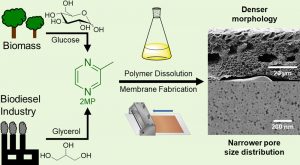
University of Alabama researchers have identified a more environmentally friendly solvent for membrane manufacturing thanks to equipment funded by the Alabama Water Institute’s CONSERVE Research Group.
A total organic carbon analyzer, or TOC, allows researchers to measure the amount of carbon present in a water sample while determining the efficiency of the new greener solvent known as 2-methylpyrazine, or 2MP.
The project, led by graduate student Joseph Danner under the supervision of Dr. Steven Weinman, aimed to reduce the use of harmful chemicals in membrane production.
“This research furthers AWI’s mission by training the next generation of scientists to provide actionable, novel solutions for water treatment,” said Weinman, UA assistant professor of chemical and biological engineering and AWI Faculty Fellow.
Water treatment membranes are key to filtering out pollutants from water, but the production of these membranes often relies on toxic chemicals. As new regulations will soon limit the use of these traditional chemicals, finding safer and greener alternatives is more important than ever.
“Incoming regulations will restrict the use of conventional solvents,” said Weinman. “We need to find sustainable, safer solvent alternatives for the membrane industry to ensure a smooth transition away from these hazardous solvents.”
The team realized that 2MP could be a more environmentally friendly solvent for making membranes. When mixed with a small amount of another solvent, 2MP was able to dissolve a commonly used polymer known as polyether sulfone. The resulting membranes had distinct structures and separation abilities compared to those made with traditional methods. While 2MP shows promise, more research is needed to see if it could be practical for large-scale use.
The TOC measures neutral solute rejection to estimate how well the membranes filter out unwanted particles. Solute rejection is key for assessing the effectiveness of ultrafiltration membranes. It is determined by the ratio or percentage of solutes that do not pass through the water filter.
“This work finds safer, more sustainable solvents to use in membrane manufacturing, which improves workplace conditions by reducing potential hazards in the communities where these membranes are manufactured,” said Weinman.
The success of this project highlights the potential of eco-friendly manufacturing practices and reinforces the importance of continued research in sustainable solutions for industries worldwide.